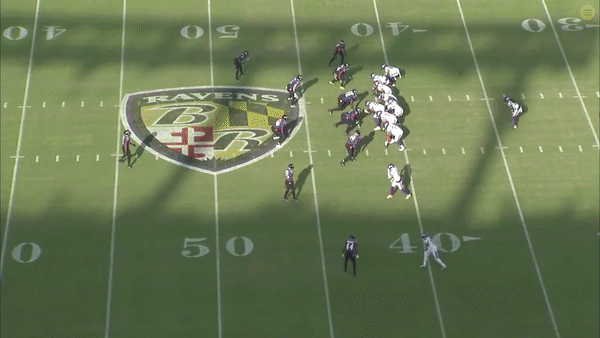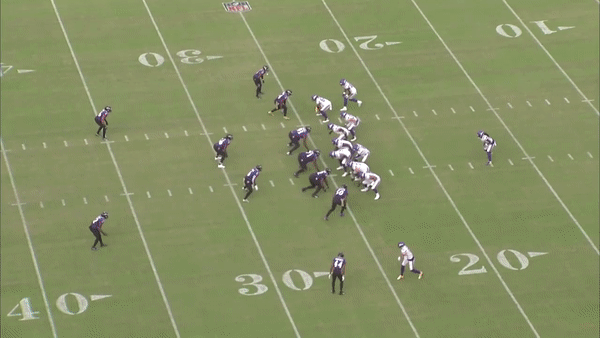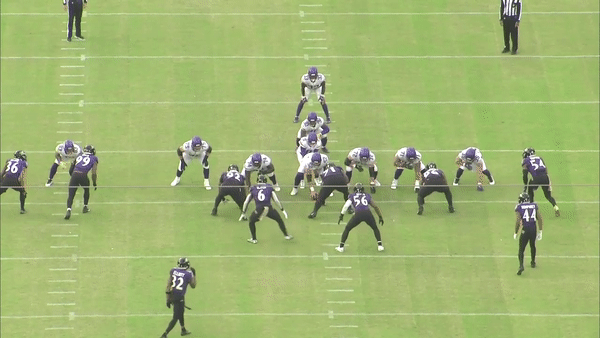Post by PurpleFloyd on Nov 14, 2021 8:57:15 GMT -6
After starting the season as an apparent top five offensive unit, the Vikings have quickly dissolved into a middling offense marked by fleeting fast starts and slogging finishes.
Their performance in Baltimore was more of the same. If not for a critical drive late in the fourth quarter — for which they deserve credit — the Vikings were unconscionably staring at a sixth game out of eight where they didn’t produce an offensive touchdown after halftime.
For a stretch of 42 minutes of gametime on Sunday, spanning five drives (not including a single play before halftime), the Vikings could only produce a field goal that was not set up by the offense but by a Camryn Bynum interception.
Matthew Coller praised Klint Kubiak’s use of the game-opening script in our Week 2 film review, which has held up. The Vikings have scored points on the opening drive seven out of eight times. How could the offense succumb to such malaise on a weekly basis?
After a 16-point dud on Sunday Night Football against the Cowboys, it was reasonable to expect a more aggressive approach against the Ravens.
“I think we changed up quite a bit on the play-calling, especially early,” head coach Mike Zimmer said after the 34-31 loss.
Indeed, the play-calling was good on the first two drives, but again, that hasn’t been the problem. Opening scripts are often around 15 plays, and since the Vikings first drive went so quickly with Justin Jefferson’s 50-yard touchdown, Klint Kubiak seemed to have some plays left over for Drive No. 2, where the Vikings also scored.
The Vikings kept their personnel unpredictable on the opening two drives, using six different personnel groupings in 12 plays. Kubiak threw in a nice wrinkle with an end-around to Jefferson, a creative run design out of “13” personnel to spring Dalvin Cook for 15 yards, a nicely-devised third down play to Jefferson and an extra linemen (Blake Brandel) in short yardage.
So why did it stagnate? Here’s what the film shows:
Difficulty with two wide receiver sets
The Vikings last season were one of the most effective teams in the NFL out of two-wide-receiver sets. Thanks to rookie Justin Jefferson’s instant impact and Adam Thielen’s presence in the red zone, Sharp Football logged the Vikings’ success rate out of “21” personnel (two RBs, one TE, two WRs) as No. 1 in the NFL among teams that used that formation over 30 times. They were also fourth in success rate out of “12” personnel, (one RB, two TEs, two WRs).
In 2021, that success has come to a sudden halt. The Vikings are third-lowest in success rate for both “12” and “21” personnel looks, which is stunning when one considers that Thielen and Jefferson are the primary receiving targets.
The struggles returned against Baltimore, where charting of each snap shows the Vikings ran 14 plays out of either “12” or “21.” They were only able to generate 54 yards on 14 plays, and 24 of those yards came on one Cook run. With that run, their per play average was only 3.9 yards, and without the run it drops to 2.3.
On several instances against the Ravens, Thielen and Jefferson were instructed to run long-developing routes that didn’t present them as options to Cousins in time to get targeted, leaving Cousins either lofting the ball to an empty part of the field or swinging it unsatisfyingly to his checkdown. (This was an issue in “11” personnel, too, most notably on the last play of the game.)
The Ravens entered as a frequent blitzing team, so it stood to reason that the Vikings would have to keep their tight ends in to block and get the ball out faster. On the play below, Jefferson runs a 15-yard route, and Thielen runs a 20-yard route. Neither are available by the time the pocket collapses, so Cousins takes Cook in the flat for four yards.

This happened periodically throughout the game, and as we’ve seen before with Cousins, once he feels like he’s got nowhere to go with the football, the checkdown can become his default.
On the Vikings’ first offensive play of overtime following Anthony Barr’s game-changing interception, Cousins appears to make up his mind immediately to swing the ball to Cook from a clean pocket instead of giving Jefferson (in the slot) a look on the corner route. Zimmer was later critical of this series of plays.

You could certainly find plays to pick apart any of the Vikings’ personnel groupings for the bulk of the Baltimore game, but the fact their two-receiver struggles were the continuation of a trend is odd for a team that has seemingly thrived with bigger personnel. This is where Irv Smith Jr. is missed the most.
Other Cousins misses
Getting the play-action going with Cousins has almost always produced good results, but as we laid out here Monday morning, the play-action efficiency is way down this season, and Week 9 was no exception. Cousins went 3 of 5 on play-action passes for 17 yards, including this fairly obvious miss of Thielen (lined up bottom of the screen), who found a soft spot in the Ravens zone. The contested throw to Conklin, instead, fell incomplete.

Crossing routes seemed to be of particular difficulty for Cousins in this game. He missed Osborn on a short cross at one point on a third down and delivered one inaccurately to Thielen, who had to adjust for the catch.
There was also a notable sequence before halftime, following Bynum’s interception, where Cousins missed consecutive throws to Thielen and Jefferson, leading to a field goal.
We focus below on the second down play, where Cousins misses Thielen high. It’s a throw that’s probably caught if it’s put on Thielen’s body, which is on the quarterback. But it feels as if Kubiak was expecting a blitz on second-and-11 that never came. The Ravens rush only four, and the Vikings have a fullback and a tight end blocking while Cook is occupied trying to sell the fake. Not many places for Cousins to look.

On the next play, Cousins hurried a throw to Jefferson that fell short on third-and-11.
“I felt on that possession, that’s on me,” Cousins said. “I felt second down, you know, we need to hit Adam on his out route, and I felt third down, on third-and-11, we need to hit Justin on his out route.”
First down woes
Three of the plays we’ve highlighted so far fall into this category. The Vikings were terrible on first downs, which correlates with another alarming trend: Minnesota has the longest third-down to-go distance in the NFL, third-and-8.1.
After the Vikings’ opening two touchdown drives, they had 13 first down attempts that generated 38 yards, or 2.9 yards per play. Once again, Cook’s 24-yard run inflates the total.
Cook was feast or famine against the Ravens with three runs totaling 105 yards and the other 14 gaining all of five yards.
The Ravens pinned Cook for a pair of TFLs late in the game, including this eight-yard loss at the hands of Patrick Queen (#6). Cook faced eight man boxes 35% of the time, per Next Gen Stats, the most he’s seen all season.

The Vikings had eight first downs where they gained zero yards or less. That’s not going to cut it on any day in the National Football League.
Their performance in Baltimore was more of the same. If not for a critical drive late in the fourth quarter — for which they deserve credit — the Vikings were unconscionably staring at a sixth game out of eight where they didn’t produce an offensive touchdown after halftime.
For a stretch of 42 minutes of gametime on Sunday, spanning five drives (not including a single play before halftime), the Vikings could only produce a field goal that was not set up by the offense but by a Camryn Bynum interception.
Matthew Coller praised Klint Kubiak’s use of the game-opening script in our Week 2 film review, which has held up. The Vikings have scored points on the opening drive seven out of eight times. How could the offense succumb to such malaise on a weekly basis?
After a 16-point dud on Sunday Night Football against the Cowboys, it was reasonable to expect a more aggressive approach against the Ravens.
“I think we changed up quite a bit on the play-calling, especially early,” head coach Mike Zimmer said after the 34-31 loss.
Indeed, the play-calling was good on the first two drives, but again, that hasn’t been the problem. Opening scripts are often around 15 plays, and since the Vikings first drive went so quickly with Justin Jefferson’s 50-yard touchdown, Klint Kubiak seemed to have some plays left over for Drive No. 2, where the Vikings also scored.
The Vikings kept their personnel unpredictable on the opening two drives, using six different personnel groupings in 12 plays. Kubiak threw in a nice wrinkle with an end-around to Jefferson, a creative run design out of “13” personnel to spring Dalvin Cook for 15 yards, a nicely-devised third down play to Jefferson and an extra linemen (Blake Brandel) in short yardage.
So why did it stagnate? Here’s what the film shows:
Difficulty with two wide receiver sets
The Vikings last season were one of the most effective teams in the NFL out of two-wide-receiver sets. Thanks to rookie Justin Jefferson’s instant impact and Adam Thielen’s presence in the red zone, Sharp Football logged the Vikings’ success rate out of “21” personnel (two RBs, one TE, two WRs) as No. 1 in the NFL among teams that used that formation over 30 times. They were also fourth in success rate out of “12” personnel, (one RB, two TEs, two WRs).
In 2021, that success has come to a sudden halt. The Vikings are third-lowest in success rate for both “12” and “21” personnel looks, which is stunning when one considers that Thielen and Jefferson are the primary receiving targets.
The struggles returned against Baltimore, where charting of each snap shows the Vikings ran 14 plays out of either “12” or “21.” They were only able to generate 54 yards on 14 plays, and 24 of those yards came on one Cook run. With that run, their per play average was only 3.9 yards, and without the run it drops to 2.3.
On several instances against the Ravens, Thielen and Jefferson were instructed to run long-developing routes that didn’t present them as options to Cousins in time to get targeted, leaving Cousins either lofting the ball to an empty part of the field or swinging it unsatisfyingly to his checkdown. (This was an issue in “11” personnel, too, most notably on the last play of the game.)
The Ravens entered as a frequent blitzing team, so it stood to reason that the Vikings would have to keep their tight ends in to block and get the ball out faster. On the play below, Jefferson runs a 15-yard route, and Thielen runs a 20-yard route. Neither are available by the time the pocket collapses, so Cousins takes Cook in the flat for four yards.

This happened periodically throughout the game, and as we’ve seen before with Cousins, once he feels like he’s got nowhere to go with the football, the checkdown can become his default.
On the Vikings’ first offensive play of overtime following Anthony Barr’s game-changing interception, Cousins appears to make up his mind immediately to swing the ball to Cook from a clean pocket instead of giving Jefferson (in the slot) a look on the corner route. Zimmer was later critical of this series of plays.

You could certainly find plays to pick apart any of the Vikings’ personnel groupings for the bulk of the Baltimore game, but the fact their two-receiver struggles were the continuation of a trend is odd for a team that has seemingly thrived with bigger personnel. This is where Irv Smith Jr. is missed the most.
Other Cousins misses
Getting the play-action going with Cousins has almost always produced good results, but as we laid out here Monday morning, the play-action efficiency is way down this season, and Week 9 was no exception. Cousins went 3 of 5 on play-action passes for 17 yards, including this fairly obvious miss of Thielen (lined up bottom of the screen), who found a soft spot in the Ravens zone. The contested throw to Conklin, instead, fell incomplete.

Crossing routes seemed to be of particular difficulty for Cousins in this game. He missed Osborn on a short cross at one point on a third down and delivered one inaccurately to Thielen, who had to adjust for the catch.
There was also a notable sequence before halftime, following Bynum’s interception, where Cousins missed consecutive throws to Thielen and Jefferson, leading to a field goal.
We focus below on the second down play, where Cousins misses Thielen high. It’s a throw that’s probably caught if it’s put on Thielen’s body, which is on the quarterback. But it feels as if Kubiak was expecting a blitz on second-and-11 that never came. The Ravens rush only four, and the Vikings have a fullback and a tight end blocking while Cook is occupied trying to sell the fake. Not many places for Cousins to look.

On the next play, Cousins hurried a throw to Jefferson that fell short on third-and-11.
“I felt on that possession, that’s on me,” Cousins said. “I felt second down, you know, we need to hit Adam on his out route, and I felt third down, on third-and-11, we need to hit Justin on his out route.”
First down woes
Three of the plays we’ve highlighted so far fall into this category. The Vikings were terrible on first downs, which correlates with another alarming trend: Minnesota has the longest third-down to-go distance in the NFL, third-and-8.1.
After the Vikings’ opening two touchdown drives, they had 13 first down attempts that generated 38 yards, or 2.9 yards per play. Once again, Cook’s 24-yard run inflates the total.
Cook was feast or famine against the Ravens with three runs totaling 105 yards and the other 14 gaining all of five yards.
The Ravens pinned Cook for a pair of TFLs late in the game, including this eight-yard loss at the hands of Patrick Queen (#6). Cook faced eight man boxes 35% of the time, per Next Gen Stats, the most he’s seen all season.

The Vikings had eight first downs where they gained zero yards or less. That’s not going to cut it on any day in the National Football League.
purpleinsider.substack.com/p/film-review-how-did-the-vikings-offense
This is a good post.
In my opinion there is enough talent on the team and all of the first drive success shows we can score on the teams we are facing if the right plays are called.
To me the way we drop off is due to the OC not keeping the team focused and not scheming to take advantage of the teams strengths. I don’t get the feeling Kubiak is confident in what he is doing after the first series and because of that the team is not confident in the execution of the plays. The offense feeds off the direction of the coach and if he isn’t projecting confidence that will show up on the field. Especially because Cousins is not a type “A” personality.
There is no question that the OC needs to go. I also believe everyone dim Rick down need to be relieved of their duty














 Just bad luck, that's all.
Just bad luck, that's all.

 Just bad luck, that's all.
Just bad luck, that's all.




 ... and neither is this Chris guy.
... and neither is this Chris guy.
